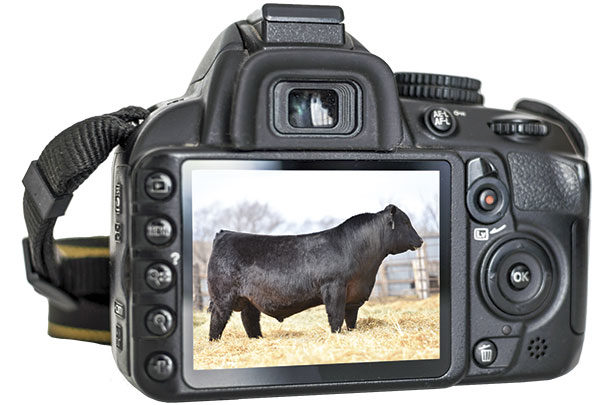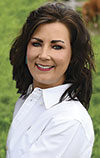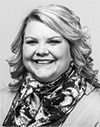Behind the camera, the photographer has to see the cattle and gauge the animal’s positive qualities and react accordingly to enhance the good and minimize the flaws.
Historically, photographers try to capture a side profile shot, where the animal’s back leg closest to the photographer is back and the off-side leg is slightly forward, with both front legs squarely underneath the animal. Some animals may look better with their legs reversed or when pictured from a three-quarter angle.
But a photo is really only as good as the picture pen setup, as well as the help inside the picture pen and back at the barn. Here are some things breeders need to consider:
Preparation
Setting a date for pictures needs to be done well in advance. This gives the photographer a chance to work you into his or her schedule and time to process the pictures and videos. Breeders need to consider advertising deadlines, as well as when the cattle will look their best. While there is no right or wrong answer, most breeders will shoot 45-60 days before the sale date to allow time for advertising and catalog preparation.
The cattle need to be prepared before the shoot date. Larger operations begin torching or shearing (depending on the time of year) about a week to two weeks out from the picture date. Then cattle are cleaned up again right before picture day to remove mud, manure, straw or other debris, as to not distract from their structure in the photo. Every sale and every target audience are different, so breeders should consider their own expectations of how their cattle should look. If they’re selling 500 bulls to commercial cattlemen, the pictured cattle may not be as “dialed in” as someone selling only 10 females in an online sale.
Picture help
Having someone to help in the picture pen is crucial. They should be able to read cattle well and move them correctly. This person should not be afraid to sacrifice their “cool” by looking silly (making animal noises, using pompoms, etc.) in order to get the animal’s attention and help the photographer get the shot. I think it is most important to get a photo in the first five to 10 minutes in the picture pen. The cattle are fresh and curious of what is going on around them, and it’s usually the best opportunity for that killer photo. If you have good pen help, you can accomplish this most of the time. But again, cattle don’t always do what we want.
The best way to keep picture day moving is to have enough help on hand. For the day of the shoot, breeders need to have cattle prepared and ready for the picture pen. It’s best to not leave the photographer waiting long in between cattle. This can really slow the progression of the day (remember, the sooner all the photos are taken, the faster the photos are back for review). When lining up help for picture day, breeders will need enough help to get cattle ready in the barn, to move cattle to and from the picture pen and have at least two people to aid the photographer in the picture pen.
Pen setup
I cannot stress enough that a good picture pen setup will ultimately make or break your photos. The animals need to be able to move around the picture pen with ease and not feel confined or crowded. I prefer a large picture pen, preferably at a minimum of 100 feet by 100 feet. It’s a lot of walking for the photographer and the help, but it makes the cattle work so much better than in a small, confined pen.
Cattle need to get out and walk into the pose, and a small pen limits that opportunity. When cattle are confined or scared, they tend to sidestep or run. When that occurs, they won’t stop in the desired stance and lift their head up for the “killer photo.”
As far as background goes, breeders should keep it clear from any distractions or anything they don’t want in the background of a photo. When building the pen, breeders should keep in mind that cattle aren’t used to be worked a lot or being surrounded by several people, so they will need a stronger picture pen set up. Think free-standing panels or something that can be quickly hopped over and the cattle will not run through. The last thing a breeder needs on picture day is to be chasing around loose cattle.
Another idea is to have a halter broke or very gentle animal in the pen or right outside the picture pen. This is an animal that will remain calm all day long and provide a “buddy” for the animal being photographed. Cattle will be calmer and more relaxed when they can see another animal nearby.
As for the ground cover, cattle should not be photographed on bare concrete or dirt. Cattle need a soft place to step and keep their footing. If they are slipping or walking on hard dirt mounds or mud, they will never take a good photo. For bull sales or production sales, we prefer the picture pen to be bedded with straw or cornstalks. In fair weather, grass or pasture cut to about 4 inches tall is best.
Time of day
This depends on the time of year. In the summer months, the sun is brutal from around 11 a.m. to 2 p.m. because it is directly above and casts harsh shadows over the cattle. Early morning or late afternoon are best for lighting in the summer months. Most production sale shoots happen later in the year or in springtime when the sun never gets really high in the sky. I like to shoot all day long in those instances. Early morning and late afternoon (especially when the days are so short) get difficult with long shadows as well.
Another thing to keep in mind is the weather. Keep an eye on weather patterns a couple of days out to assure good weather on picture day. If it looks like rain or snow, rescheduling needs to be done with the photographer and help.
DIY photos
Sure, anyone with a digital single lens reflex (DSLR) camera can take the photos, but there is real value in working with a professional. When hiring a professional livestock photographer, a breeder is getting the best photos possible. They will be able to make adjustments on black cattle versus colored cattle or shooting on a cloudy day or sunny day – a good, seasoned photographer will make adjustments on their camera based on lighting. Additionally, the finished photos will be cropped, sized and ready for the graphic designer. The combination of correct camera settings, right pose on the cattle and print-ready images will bring out every detail and make the photos pop off the page of a sale catalog.
Quality images should increase sale averages and bring in new buyers. Breeders spend years making breeding decisions, calving them out, raising them right and preparing them for sale day. The way cattle are represented in a sale catalog will pay off tenfold. That bull or female can and will go on to make an impact in someone else’s herd, and the photo is the first step. ![]()
PHOTO: Livestock photography is more than just luck; it takes careful planning, timing and a good setup on picture day. Illustration by Philip Warren.
Robin Kleine is also with Focus Marketing Group Inc. and works as a photographer, graphic designer and social media manager.

-
Kyla Fawcett
- Owner
- Focus Marketing Group Inc.
- Email Kyla Fawcett












